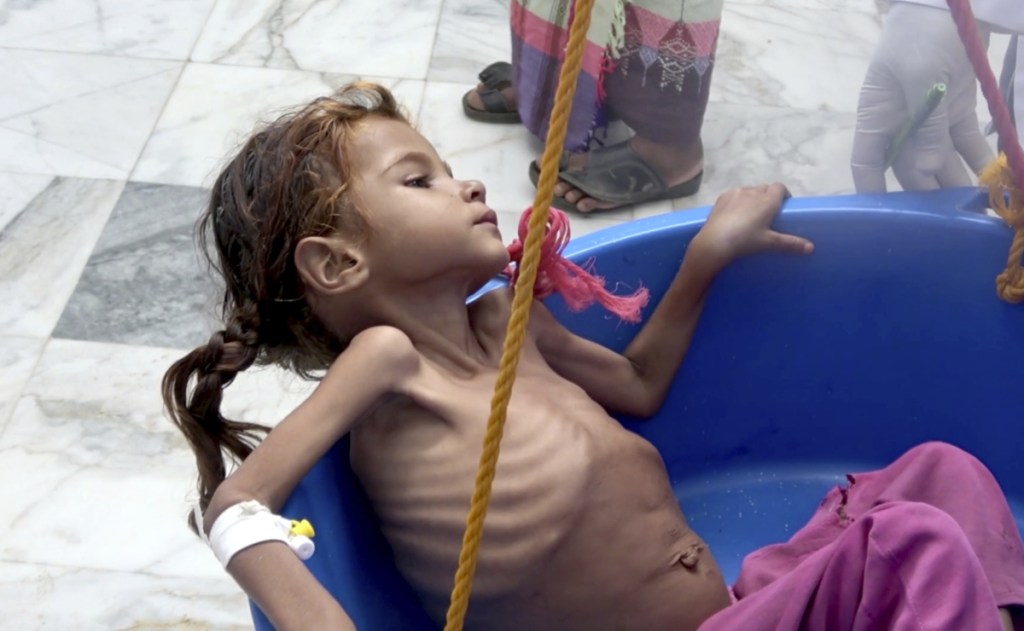CAIRO — In a remote pocket of northern Yemen, many families with starving children have nothing to eat but the leaves of a local vine, boiled into a sour, acidic green paste. International aid agencies have been caught off guard by the extent of the suffering there as parents and children waste away.
The main health center in Aslam district was flooded with dozens of emaciated children recently. Excruciatingly thin toddlers, eyes bulging, sat in a plastic washtub used as a make-shift scale as nurses weighed each one. Their papery skin was stretched tight over pencil-like limbs and knobby knees. Nurses measured their forearms, just a few centimeters in diameter, marking the worst stages of malnutrition.
At least 20 children are known to have died of starvation already this year in the province that includes the district, more than three years into the country’s ruinous civil war. The real number is likely far higher, since few families report it when their children die at home.
In a nearby village, a 7-month-old girl, Zahra, cries and reaches with her bony arms for her mother to feed her. Her mother is undernourished herself and is often unable to breastfeed Zahra.
“Since the day she was born, I have not had the money to buy her milk or buy her medicine,” the mother said.
Zahra was recently treated at the heath center. At home, she’s dwindling away again, and her parents can’t afford to hire a car or motorbike to take her back to the clinic.
If they don’t, Zahra will die, said Mekkiya Mahdi, the health center chief.
“We are in the 21st century, but this is what the war did to us,” Mahdi said. She said she tours Aslam’s villages and, after seeing people living off the leaf paste, “I go home and I can’t put food in my mouth.”
The worsening hunger in Aslam is a sign of the gaps in an international aid system that is already overwhelmed and under pressure from local authorities. Yet outside aid is the only thing preventing widespread death from starvation in Yemen. The conditions in the district may also be an indication that humanitarian officials’ warnings are coming true: In the face of unending war, hunger’s spread is outstripping efforts to keep people alive.
When U.N. agencies were questioned about the situation in Aslam, they expressed alarm and surprise. In response, international and local aid groups launched an investigation into why food wasn’t getting to the families that need it the most, a top relief official said.
As a response in the meantime, the official said, relief agencies are sending over 10,000 food baskets to the district, and UNICEF Resident Representative Dr. Meritxell Relano said the organization is increasing its mobile teams in the district from three to four and providing transportation to health facilities.
Yemen’s civil war has wrecked the impoverished country’s already fragile ability to feed its population. The war pits Shiite rebels known as Houthis, who hold the north, against a Saudi-led coalition, armed and backed by the United States. The coalition has sought to bomb the rebels into submission with an air campaign in support of Yemeni government forces.
Around 2.9 million women and children are acutely malnourished; another 400,000 children with severe malnourishment are fighting for their lives only a step away from starvation.
The number of people nationwide who would starve if they didn’t receive aid grew by a quarter over the past year, now standing at 8.4 million of Yemen’s 29 million people, according to U.N. figures. That number is likely to soon jump by another 3.5 million.
Send questions/comments to the editors.



Success. Please wait for the page to reload. If the page does not reload within 5 seconds, please refresh the page.
Enter your email and password to access comments.
Hi, to comment on stories you must . This profile is in addition to your subscription and website login.
Already have a commenting profile? .
Invalid username/password.
Please check your email to confirm and complete your registration.
Only subscribers are eligible to post comments. Please subscribe or login first for digital access. Here’s why.
Use the form below to reset your password. When you've submitted your account email, we will send an email with a reset code.